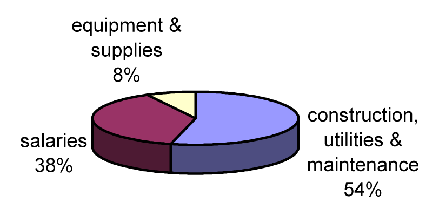Economics and Usage of Digital Libraries: Byting the Bullet
Skip other details (including permanent urls, DOI, citation information): This work is protected by copyright and may be linked to without seeking permission. Permission must be received for subsequent distribution in print or electronically. Please contact mpub-help@umich.edu for more information.
For more information, read Michigan Publishing's access and usage policy.
The Cost of Print
Table 15.1 shows the cost estimates for book storage and access. These costs are based on the cost of the Thomas Fisher Rare Book Library at the University of Toronto. Construction costs are based on the 1999 library construction project at the University at Albany. Special environmental controls used in a rare book library imply that the construction costs in Table 15.1 may underestimate the actual construction costs. All costs are shown in Canadian dollars (CD).
| Cost | Cost/volume | Cost/use | |
| Construction, utilities and maintenance | $1,586,056 | $3.17 | $72.51 |
| Salaries | $1,105,031 | $2.21 | $50.52 |
| Equipment and supplies | $255,799 | $0.51 | $11.69 |
| TOTAL | $2,946,885 | $5.89 | $134.72 |
The cost of construction, utilities, and maintenance is comparable to an estimate of $4.68CD (Bowen, 1998) and a 30-year amortization of $6.33CD reported in this book (Kantor et al., this volume). However, the cost per use of $134.72CD is significantly higher than the $1.50CD cost of retrieval previously reported (Bowen, 1998), the $3CD cost of retrieval for the New York Public Library and $6CD for the Harvard Depository Library (Lesk, 1998), or the $9CD maximum retrieval cost reported elsewhere (Getz, 1997). In Table 15.1, the cost per use is derived by dividing total cost by the number of annual requests for books. This inflates the cost per retrieval by adding the costs of storage into the equation. However, it is important to note that the "service" of a library is the use of its materials. All costs when divided by the use of those materials gives an average cost for service which will be higher than separating out only part of these costs for retrieval.
For a comparison with other estimates of retrieval costs, an estimated 80 percent of salaries at the Thomas Fisher Rare Book Library are for access. Taking 80 percent of salary costs yields an estimate of $40CD per transaction for labor, still significantly higher than other estimates. However, a rare book library has concerns of preservation that require additional staff care and monitoring for patron access. In addition, this estimate includes the total cost of administration, vacations, and benefits for employees rather than the marginal cost of retrieval based on a staff member's time spent multiplied by his salary.
Table 15.1 does not include the cost of purchasing a book. This is important although it will be a small percentage of total costs once the purchase price is amortized over the expected life of storage and use of the book. For example a rare book that costs $500 but is expected to last 100 years in storage has an annual cost, when amortized, of $4.80. Table 15.1 also does not include the value of the land. This can be significant but is different depending on the location of the library.
Figure 15.2 shows the categories of rare book annual storage and access costs as a percentage of total costs. As expected, the largest component of total costs for books is the cost of space to store them.


